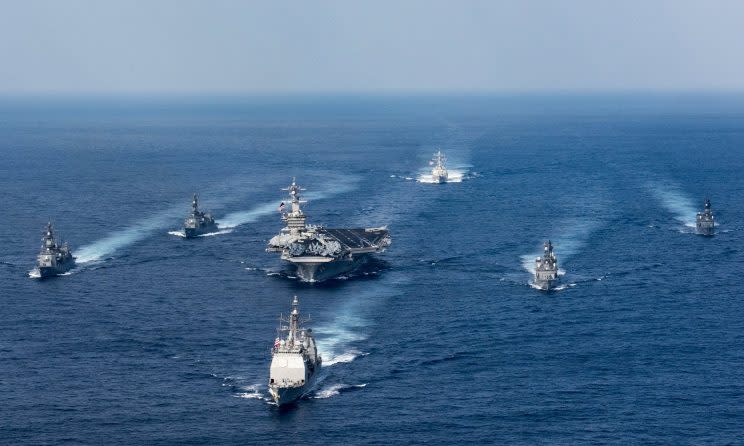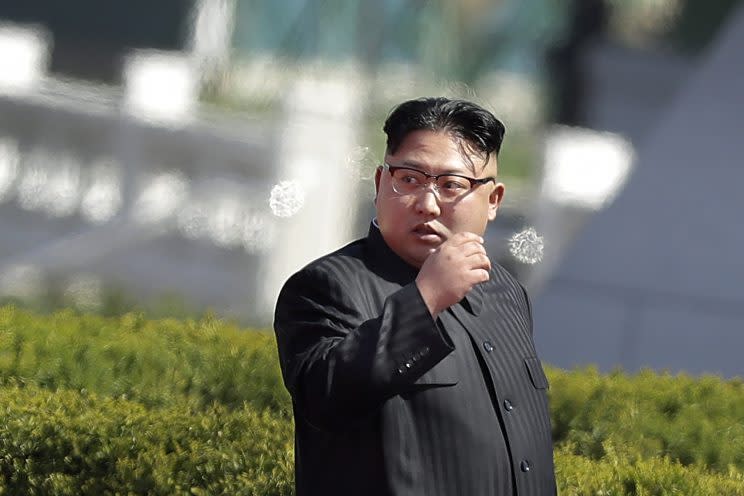Would Donald Trump actually attack North Korea?

Tensions between North Korea and America have reached a historic and worrying high during Donald Trump’s presidency.
As an ‘armada’ of U.S. ships steams closer to the Korean peninsula in show of force, Kim Jong-un has warned that he will respond with a nuclear attack at the first sign of aggression.
While his predecessor Barack Obama delivered stern warnings to the hermit state that his country could ‘destroy’ them, President Trump has upped the rhetoric.
Taking to Twitter, President Trump declared he was willing to ‘solve the problem’ of North Korea.
North Korea is looking for trouble. If China decides to help, that would be great. If not, we will solve the problem without them! U.S.A.
— Donald J. Trump (@realDonaldTrump) April 11, 2017
His Secretary of State Rex Tillerson has echoed Trump’s bravado, saying that ‘the policy of strategic patience has ended’ and ‘all options are on the table’.
But would the President actually press the red button, considering the risks?
Are Donald Trump’s threats serious?
Emil Dall, Proliferation and Nuclear Policy Research Fellow at the Royal United Services Institute, told Yahoo News UK: ‘What we’ve seen with President Trump is that he’s very keen to make clear to Americans that military action is now a feasible response.
‘We have to remember that previous administrations have probably had military action as part of their toolkit – what might have happened with Trump is that that option is brought further forward.’
But there’s no disputing the fact that President Trump has quite a track record of mighty claims that haven’t quite materialised.
Mr Dall added: ‘I think there is also a certain posturing going on from President Trump’s side.
‘There’s a lot of tough language, which feeds in very well with his language on domestic politics and even towards countries in Europe.
‘But then again we are at a point in North Korean /U.S. relations that are incredibly tense. Possibly more tense than they have been for many years.’

What would Trump’s strategy be?
Dr Benjamin Habib, lecturer at the School of Social Sciences, La Trobe University, wrote in The Conversation that ‘surgical airstrikes’ are likely to be Trump’s favoured approach. This would mean destroying Pyongyang’s nuclear arsenal without the devastating civilian casualties an all-out strike would undoubtedly cause.
It is a similar approach to that he took in Syria when he authorised the bombing of a military airfield. In the case of North Korea, it could mean targeting the country’s nuclear infrastructure.
For such a strategy to be successful, the critical sites would have to be destroyed entirely to kill off the threat of retaliation.
But Dr Habib says that ‘the bombs themselves, and the stockpiles of fissile material – are likely to be buried deep in secret, reinforced underground facilities, protected from aerial attack.’ There would also be a huge risk of radioactive contamination to surrounding regions.

A surgical airstrike could also target Kim Jong-un himself, with a view to bringing about regime change in the event of his death.
This would be astronomically risky. If a strike were to miss and the despotic leader survived, it could lead to a brutal retaliation.
How would North Korea retaliate?
Evidence suggests that North Korea does not currently have the capability for a nuclear attack against America. Yet.
Proliferation and nuclear policy analyst Emil Dall told Yahoo News UK: ‘North Korea vowed to develop an intercontinental ballistic missile capability that can reach the continental United States.
‘And they’re fast progressing towards that effort. A few years ago we were talking about whether North Korea was able to miniturise their nuclear warheads to be able to go onto a missile.
‘I think most analysts would agree we have to assume that line has now been crossed.
‘When we’re discussing the ability of their missiles to travel such a long distance there’s still some question about that. But given the determination of the North Korean regime it’s a matter of when not if they will acquire that capability.’
Assuming North Korea isn’t able to target the U.S. with nuclear weapons, it would likely turn its attention to the South Korean capital of Seoul. The city is incredibly exposed thanks to its proximity to the border.
Civilian casualties could be catastrophic, and a nuclear attack could lead to years of radioactive fall-out.
On top of the humanitarian tragedy, the alliance between the U.S. and South Korea would be left in tatters if a sloppy military strike by America sparked an attack on Seoul.
Given the potential for humanitarian tragedy that would inevitably result from U.S. action against North Korea, it is surely a last resort for Trump.
America’s military muscle outweighs North Korea’s, removing Kim Jong-un’s incentive to act first in a conflict.
Dr Benjamin Habib writes: ‘Trump’s foreign policy team would do well to think through the logic of their escalation.
‘A North Korean first-strike nuclear attack against the U.S. or its regional allies makes little sense for North Korea.
‘From this perspective, it is a strategic restraint on America’s part based on deterrence – rather than unnecessary unilateral muscle-flexing – that’s more likely to preserve regional stability.’


